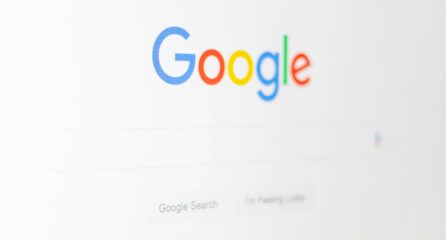The world of digital marketing changes so frequently that it can be hard to know what’s next in store. 2021 has been another year that has kept us digital marketers on our feet. As people land upon a sense of ‘normality’ following a turbulent 2020, consumers’ priorities evolve and we at Loom have reshaped and refined our strategies to keep up with the rapidly changing landscape.
As 2021 comes to a close, we’re looking ahead to 2022 and sharing our digital marketing predictions. Keep reading to see what we think lies in store.
Digital Strategy
With many changes on the horizon, digital marketers have had to adapt their strategies to suit this year, and 2022 will be no different. With an increased focus on privacy and personalisation, digital strategies will need to integrate a range of platforms to ensure that users are getting the experience they deserve, and that clients’ get the results they want.
We kick off the predictions with Nikki Ellison and Karen Pearce, and what they think digital strategies will look like in 2022.
Agencies as solution providers, not just service providers
Nikki Ellison

Most businesses have faced numerous challenges this year which has put them under a huge amount of pressure. Boardroom agendas have not only been dominated by Covid, but also supply-chain woes, digital skills talent shortages, sustainability, diversity, digital transformation, and more. These have created different challenges for Marketing departments, which are here to stay for 2022 and beyond. Agencies have a role in helping businesses to solve some of these pain-points and together help shape a better and more successful future for all. Agencies of the future need to become solution providers rather than service providers.
2022 quick win:
- Continue to nurture and expand your professional network and peer-to-peer support – a great source for ideas, insight, knowledge and solutions.
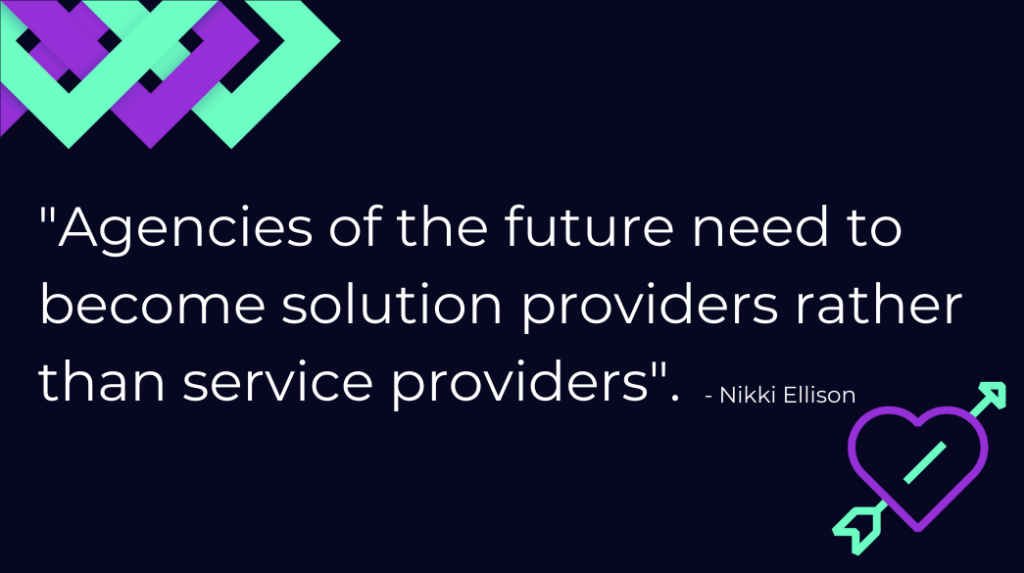
Account Based Marketing (ABM)
Karen Pearce

As we move towards a cookie-less world, first party data becomes more pivotal and in turn account-based marketing (ABM) even more crucial for B2B and B2C businesses.
This is nothing new, as marketers are already moving towards account-based marketing. But accelerating this move is the scramble for first party data as the removal of third party cookies in 2023 nears. Businesses are investing in first-party data collection and account-based marketing will make this investment worth it.
There are several trends in B2B ABM that are particularly exciting for digital marketers:
- Targeting buyer groups. B2B ABM is likely to target groups of individuals who are all involved in decision-making, rather than targeting one individual. This offers additional opportunities to target additional job titles in an organisation hitlist.
- Buyer enablement. Buyer enablement will continue to grow in importance. It gives your client the information they need at the right time to support their decision-making process. It requires the seller to understand the user journey, and what questions that user may have along the way. This requires the marketer to communicate the value of their product or service to the user’s business. This is particularly exciting for content writers who can produce well-researched, unique content that meets your targets needs and search intent.
For B2C, ABM is an emerging strategy, and efforts lie largely in the personalisation angle. Advances in technology combined with an increase in collecting and sharing first-party data makes personalisation accessible to more marketers. But consumers are also expecting a personalised experience, and the rewards are high if retailers get this right.
Trends to look out for in B2C ABM include:
- Consistency of personalisation online and offline. Retailers will likely start using online data to better personalise user experiences in-store. Technology such as beacons or sensors, or even just apps will make it increasingly possible to personalise an in-store visit based on a customer’s online activity. John Lewis has recently teamed up with ITV & ‘I’m a Celebrity…’ to allow users to visit their store within the game Fortnite.
- Apps will allow retailers to personalise customer experiences without having to rely on cookies. Combined with faster loading speeds, improved customer retention and easier access to sales support, it’s no wonder that apps are top of many retailers’ marketing priorities.
2022 quick wins:
- Look at your online and offline ‘traffic’ as a whole and create an overarching footfall strategy. This will help you work towards a seamless customer experience, wherever it takes place.
- When creating your content strategy, be sure to speak to your customer-facing teams. They will be able to give insight into customers and potential customers on-trend topics and pain points.
Social Media Predictions for 2022
The social media landscape has certainly had a shake up in the last year. Consumers are spending more time on social media, Tik Tok is making waves, and Gen Z are fueling a shift towards non-traditional social media marketing methods, as businesses start reaching out to them. Brands have certainly had to adapt within this industry.
In their predictions, Alice Fry and Ellen Stone take a look at how businesses can adapt to these social media trends in 2022.
Stand out or stand down – time to get creative with your paid social ads
Alice Fry

Businesses will continue to harness the power of social media ads in 2022, with Hootsuite’s latest report identifying that 51.4% of marketers are planning to increase their paid social ads next year. So, that means just a massive increase in the same old, brand-driven narratives, right? Think again.
Consumers are wise, and the same old ad techniques just won’t fly anymore if you want the clicks – and of course, the conversions. Users (particularly Gen Z) are now acutely aware they are being advertised to, so there’s no pulling the wool over their eyes. It’s time to get real. But how? Brands will need to get increasingly creative in 2022 and begin to adopt the less traditional social media networks for paid ads such as Snapchat, Pinterest and, of course, the rising (mega)star, TiK Tok.
It’s important to add that it doesn’t mean Facebook and Instagram are null and void, your ads will just need to get more creative to keep up.
Brands will get to the heart of who they are and their personality. This will be key in discovering where they fit into the narrative. Harnessing this and the value they bring to the customer will be vital to creating authentic, entertaining ads that work seamlessly on the chosen platform.
2022 quick wins:
- To stand out, don’t play it safe – you need to be fearless. As long as it feels authentic to you and not the familiar ’self-serving’ ads we’ve all seen, then it should work. If not, you’re at least heading in the right direction. Test (it’s unlikely to happen overnight!), experiment and provide your team with the space (and training) to facilitate this on the right social media channels for you.
- Creators or ‘Influencers’ aren’t new – it’s time to start working with them more creatively. Ads should feel authentic and the creators should be the right fit with your brand voice and the platform. Coming up with an idea and then handing over the creative reins to a creator may pay off. Also, remember, subtle brand mentions can be key in making the ad a seamless experience.
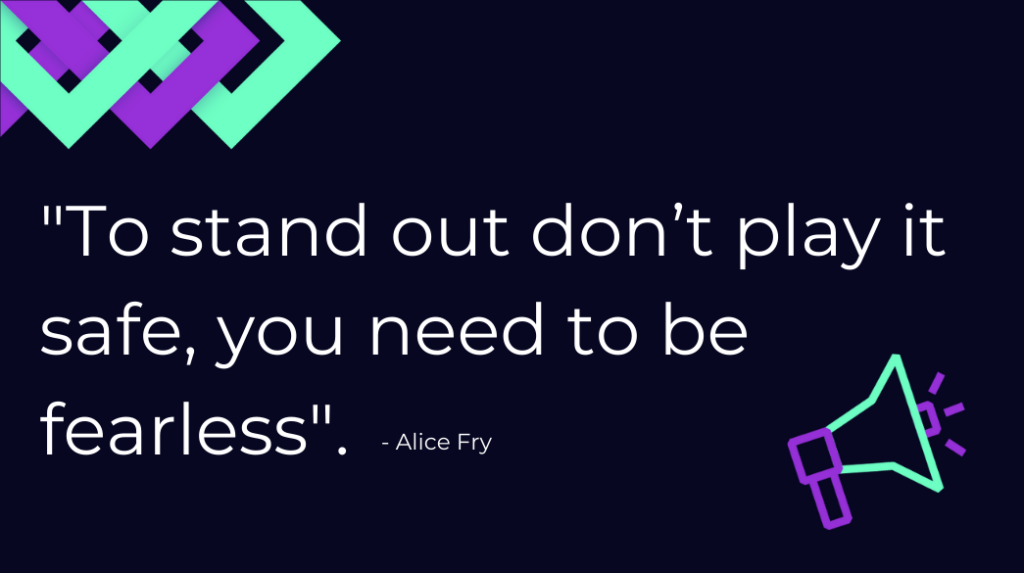
The rise of TikTok
Ellen Stone

Since the pandemic began in 2020, TikTok has been at the forefront of the digital landscape, becoming one of the fastest growing social media platforms ever. Other channels like Instagram have replicated TikTok with their ‘Reels’ video function, and now even specific effects like the text-to-speech feature. In September 2021, it was announced that the app had reached 1 billion monthly active users; so it will come as no surprise that we expect TikTok to dominate the social media space in 2022.
TikTok has created an excellent opportunity for all brands, allowing for short-form, low-production value content. Big budgets aren’t needed here to make a lasting impact. As the platform doesn’t follow the typical best practices required for sites such as YouTube or Instagram, creating video content just became a lot more accessible.
TikTok trends are one of the most integral parts of this app. Trends can include a specific song, sound, special effect or transition that users will utilise to create content. Brands like Ryanair and Duolingo have jumped on the TikTok bandwagon, with 36 million and 27.5 million video likes, respectively. They’re now renowned on the platform, becoming famous through interacting with numerous viral trends and reaping the rewards.
2022 Quick Wins:
- TikTok is only going to become more integral to digital marketing in the future, so start early, sign up, and determine how you want to be present on this channel.
- Content that excels on TikTok is ‘authentic’. Users engage with clips that have personality, are educational or even inspiring. For brands, this is an opportunity to give your company a tone of voice and connect on a different level with your customers. Quick wins include behind the scenes videos, such as :
- Product packaging
- Product design
- Employees taking part in trends
- You’ll have to consistently use the app to identify patterns in upcoming sounds and songs. Trending sounds and effects are constantly changing, so if you spot a pattern early, get involved as soon as possible because you might go viral. Work with your internal team to come up with a creative way to interact with a trend that’s a little different from everyone else. It doesn’t have to be complicated – just think outside the box.
Want to find out more about TikTok? Click to read our guide on the impact of TikTok on digital marketing.
PPC & Biddable Media predictions for 2022
The world of PPC and biddable media is constantly evolving, and 2021 was no exception. With a cookie-less future fast approaching, tracking may become more difficult as marketers rush to find ways to measure their campaign results. This element of uncertainty makes it hard to predict the future of the paid landscape, but our PPC and Biddable media team have shared their thoughts below.
First-Party Data
Tommy Pearson

With third-party cookies well on their way to dying out, owning your own data will only become more important. Having a robust strategy around collecting, segmenting and utilising first-party data will not only help you, but also give your customers a far better experience of your brand.
This can be done with a good CRM, some clever tech (such as metorik.com) and a clear and transparent privacy policy. But more importantly, you want your customers to be signed up because they want you to reach out to them on their devices. With some nicely segmented first-party data, your customer will receive more personalised ads, which will lead to a far better brand experience, and your retention rates will only get better. Off the shelf audiences from the major ad platforms are on course to become far murkier, so take back control and give your audience the experience they deserve.
2022 quick wins:
- Choose a CRM that allows you to segment your customers logically
- Be transparent with how you use your customers’ data
- Give your customers a more personalised experience
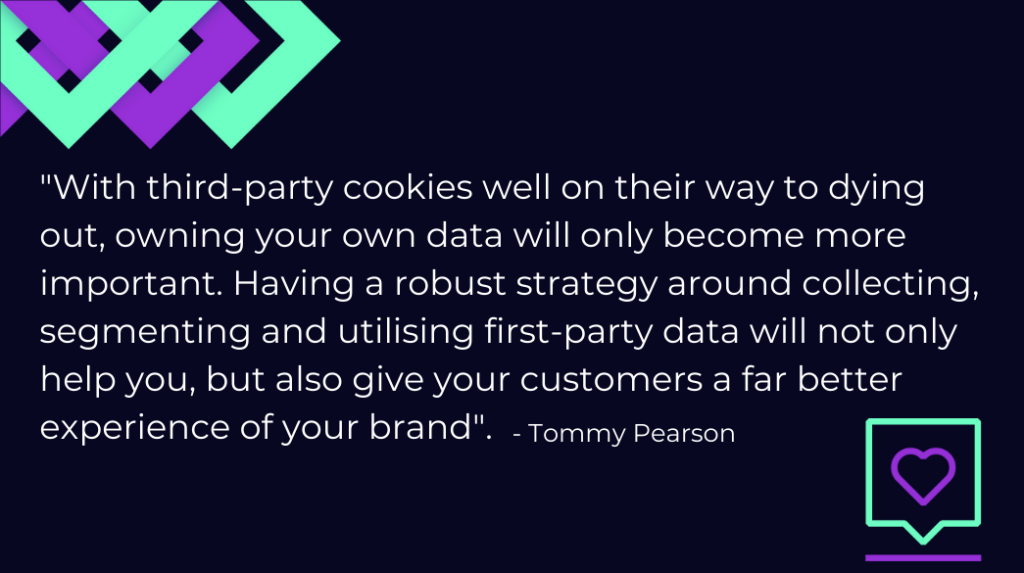
Data Capture Ads
Matt Cooper

With new regulations already in place and a cookie-less world around the corner, advertisers and companies will need to pivot their digital marketing strategies in order to achieve their goals. First-party data will have to become (if not already) a vital component of business’s strategies. Advertising platforms will continue to become more reliant on this data in order to target and find new customers/audiences.
Companies are increasingly using their websites to capture basic customer details, such as name, address, phone numbers and email address, securing an opt-in to use the customer’s email address and mobile phone number for future marketing communications.
The best time to start collecting this first party data is now!
2022 Quick Wins:
- The sooner companies start to collect this first party data the better. The larger the pool of data the more accurate advertisers and the platforms can be in terms of targeting. Companies should be utilising ad types that capture customer information, newsletter/mailing list sign ups is a great example of this. The key is to give something in return, and to avoid asking for too much at the point of initial registration. You can always go back to these customers once you have their permission to talk to them.
- Traditionally, B2C advertising campaigns have been largely focused on ROAS or Revenue. Whilst this is still obviously vital for these companies, they could utilise different approaches in order to achieve both Sales/Revenue/ROAS and data capture. Offering discounts or early access if users sign up or provide data such as email addresses is a great example of this.
Privacy-Safe Measurement Solutions
Westley Cogan

With fewer cookies and other identifiers on the horizon, measurement of digital marketing performance will become more & more difficult, especially in the Paid Media landscape.
Marketers need to adapt and implement new ways of accurately measuring campaign performance while respecting user consent.
To accomplish this task, marketers should utilise privacy-safe solutions that augment measurement gaps with additional data sources that can enable modeling. For example, Enhanced Conversions is a measurement system which takes first-party data from purchases, and then matches these to Google accounts to improve conversion tracking. Consent mode is another way to model conversion tracking with privacy in mind.
As well as this, 2023 will be cookie-less, with Federated Learning of Cohorts (FLoC) potentially rolling out, which “technically” respects privacy.
2022 quick wins:
- Enhanced conversions help advertisers unlock a more accurate picture of their media performance. With this solution, advertisers can share first-party, user-provided data via their existing tags, which helps identify conversions otherwise unobserved by tagging alone.
- Websites will need to allow site visitors to set their consent choices for cookie usage and if people do not consent, brands will need to turn to Consent Mode. Consent mode helps adjust the behaviour of Google tags to respect user cookie consent choices and provides conversion modeling, so brands can understand which marketing campaigns are most effective at driving conversions.
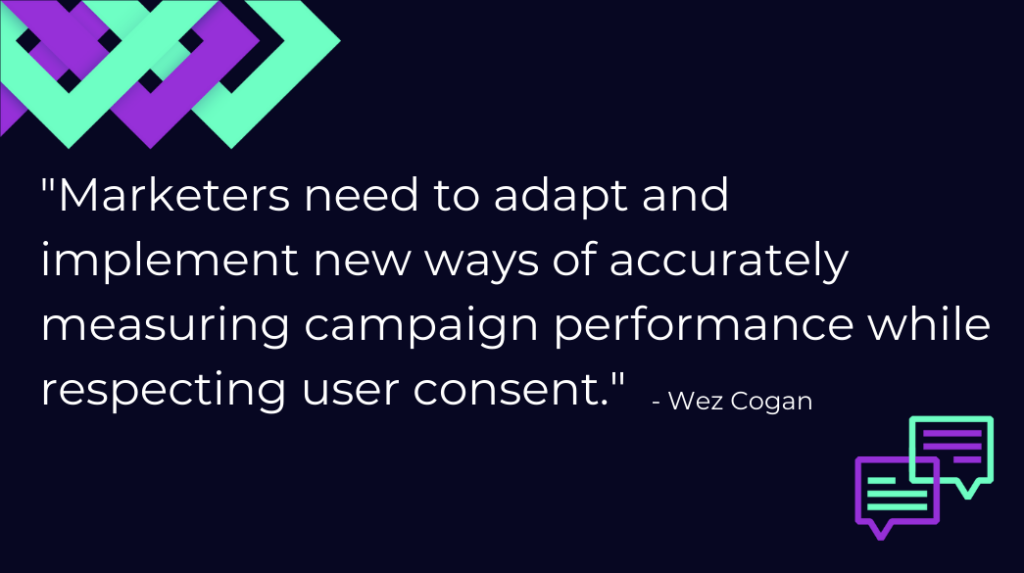
Automation in PPC
Sam Gosling

Automation in PPC is definitely not new, but in 2022 it is going to become more commonly used and important to advertisers. Advertisers have long been sceptical of automation for many reasons. Some believe that automation takes away their control, and is not as good as humans when it comes to strategy and prior situational knowledge. However, over the last few years there is no doubt that automation in PPC has come a long way and advertisers have started to see results. Automation is here to stay so here’s what advertisers need to be doing in 2022.
2022 could be the year that automation is taken to a whole new level and advertisers need to start embracing it. At Loom we have seen fantastic results off the back of using automation across different industries and levels of spend, however there is no blanket approach. We encourage clients to test automation with us where possible and always with a strategic approach to it. Deploying automation strategically can be a great tool to help drive better performance, scale activity and grow your brand.
The way we use automation and how we use it is certainly going to change in 2022. Most importantly, advertisers need to make sure that they are using the best possible data available to them.
2022 quick win:
- Ensure your tracking is fully configured and make use of your offline and 1st party data as much as possible to get the most out of automation.
Retro is king and Marketing Mix Modelling is back with a bang
Jacob Zurawski

Remember the 1960s? Good times. Capri pants were the latest fashion invention, Sophia Loren stole our hearts from the silver screen, and marketers finally learned how to optimise advertising using Marketing Mix Modelling (MMM). Then came the shiny Data-Driven Attribution and nothing was ever the same. Till it wasn’t. Or Isn’t.
With cookies potentially going and tech companies disrupting tracking methods, MMM is making a big comeback. But what is MMM? It allows marketers to get high-level insights into campaign effectiveness. It can determine the relationship between the dependent variable, such as sales, and the independent variables, such as ad spend across channels. The outcome allows marketers to assign a numerical value to the impact of campaigns across various media channels towards achieving their goals.
MMM isn’t, unfortunately, the saviour of your marketing attribution struggles. It disregards placement specifications or brand/messaging. However, it’s still worth giving it a shot, as it should steer you over the dark waters of missed conversions by using a mix of past and present data -though it needs a lot of it.
2022 quick wins:
- Jump on the MMM hype train quickly but with careful consideration. Do you have the necessary data? How good is that data?
- Don’t over-rely on MMM. Remember, there are still good insights hidden in data-driven platform reports.
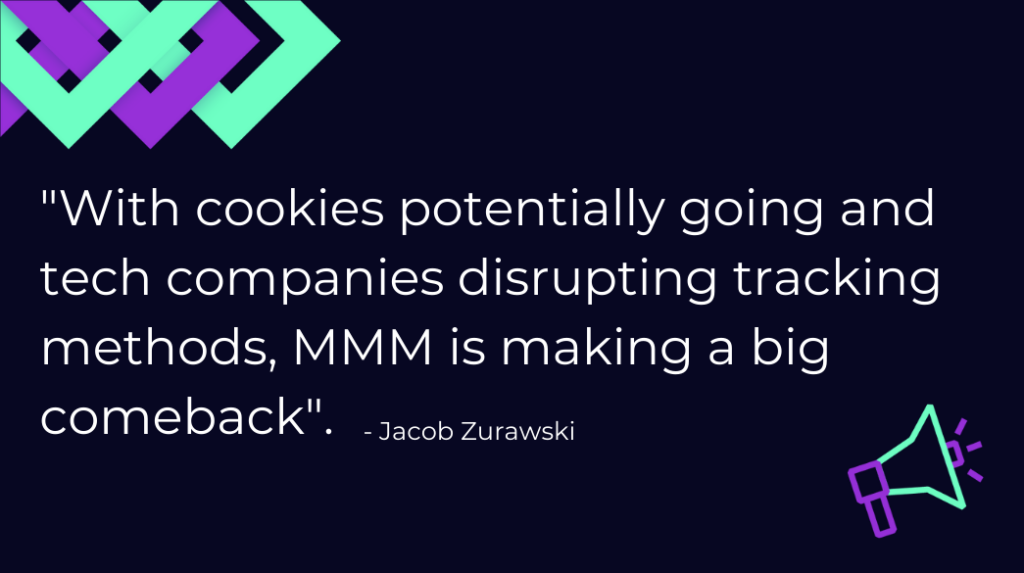
Customer experience will be key in getting customers & keeping them
Romy Gwilym

Every year is the year of the customer and we all know how important user experience is and how it can affect conversion rates and loyalty. With the increase in brands and companies opting into PPC & Biddable, you won’t be able to rely on simply being seen anymore.
Lockdown has changed user behaviour, leading to higher levels of indecisiveness, impatience and friction. So, creating a personalised and efficient user journey can set you aside from your competitors, and support a better brand community which in turn should drive loyalty.
2022 quick wins:
- Focus on mobile optimisation first (before desktop) – page speeds and navigation ease. Remember mobile is normally the first touch point
- Think efficiency, convenience, knowledgeable and friendly customer support, and easy payment options
SEO & Content predictions for 2022
The SEO and Content landscape have also changed. User experience continues to be a priority, as demonstrated by the roll out of the Page Experience update earlier this year. With further updates on the horizon, brands must put consumers’ needs first, ensuring that they’re answering all users’ questions and optimising for their journey as a whole.
Our SEO & Content team reflects on the above and predicts what lies ahead in 2022.
The MUM Update and a shift in mindset
Laurence Matone

Over the last few years, Google has made fantastic leaps with Natural Language Processing to improve search results. With BERT now fully rolled out, we’ll start to see small-scale deployments of the hotly anticipated MUM model over the coming year. Google’s MUM algorithm is a game changer because it can understand the nuances of a query and retrieve multiple pieces of information from the best sources to produce an answer. MUM can also do this across 75 languages, so if there’s a piece of information needed to satisfy a query but it’s in a different language, it can be found and translated.
Depending on how fast MUM is drip-fed and tested over the coming year, we’ll likely see a search industry shift in mindset from:
Seeing a single page as the sole source for satisfying a query to… a page containing one source of information recruited in tandem with other pages containing other kinds of information to satisfy a query.
In the year ahead, we’ll see a shake-up in terms of how click-through rates are distributed amongst the Search Engine Results Pages (SERPs). Google recently rolled out infinity scrolling for mobile which means that up to four pages of results can be displayed within a single finger flick. By removing the physical step of page clicking, users will have access to results beyond page one with no extra effort. I think we’ll see clicks landing further into top 20, 30 and 40 positions.
2022 quick win:
- Now more than ever it’s time to really drill down on your meta titles and descriptions so that your pages display clearly and entice those adventurous infinity scroll users!
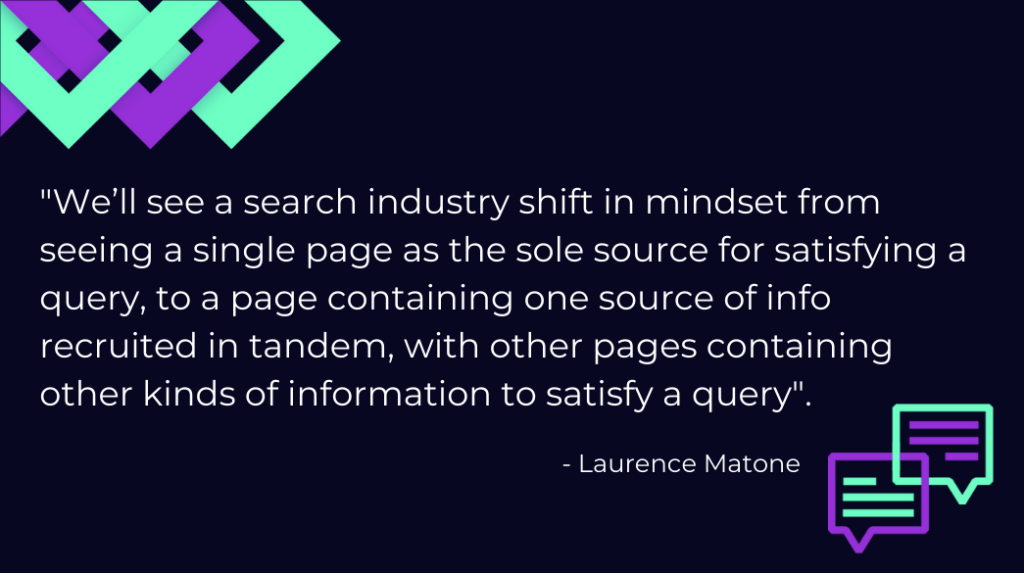
Semantic SEO & Topical Clustering
Tom Spooner

Semantic SEO and topical clustering is nothing new. At Loom, we’ve taken this approach to website content for years. It’s got to the point now though that if it’s not guiding your SEO and content strategies in 2022 then you risk being left behind in the organic space.
Search engine algorithms have become increasingly intelligent around semantics and understanding user intent (the meaning behind the search query). Alongside that, they rely more on the relationship between topics. Our job as SEOs and content marketers is to show that we understand the topics related to our clients’ service and how best to meet users’ needs through our content. Structuring your content and in turn website based on topical clustering should see improved and expanded rankings, more relevant traffic and very satisfied users.
2022 quick win:
- Move away from keywords as your starting point and embrace topic clusters – groups of related content around a much broader area of knowledge. What you’re aiming for is a website that makes connections between relevant topics and delivers genuine value for users. What does the user actually need? And what other questions are they going to want answers to? Consider how you answer these questions on your website and you’ll be off to a good start.
Adapting to changing user behaviours
Chloe Price

Users expect content which helps them along their buying journey, that is catered towards their needs and provides them with a solution. However, with user behaviours constantly changing, it’s more important than ever to understand your audience and what they need – even if they don’t realise it yet.
By further segmenting users into more granular personas, you can better meet your audience and in more places than before. This allows you to create content specifically for them, no matter how far they are into their buyer journey. The need for personalised content is on the rise, and you can give your customers exactly that – once you better understand them.
Of course, this won’t come without its challenges. With more touchpoints to consider, brands will need to think carefully about how they present their content, and whether they’re using the right tone for particular user personas. A carefully mapped-out content strategy which covers multiple channels is required for this.
2022 quick win:
- Refresh your audience research to ensure that you understand your target audience, digging deeper into their needs and desires. You can then integrate this data into your content strategy.
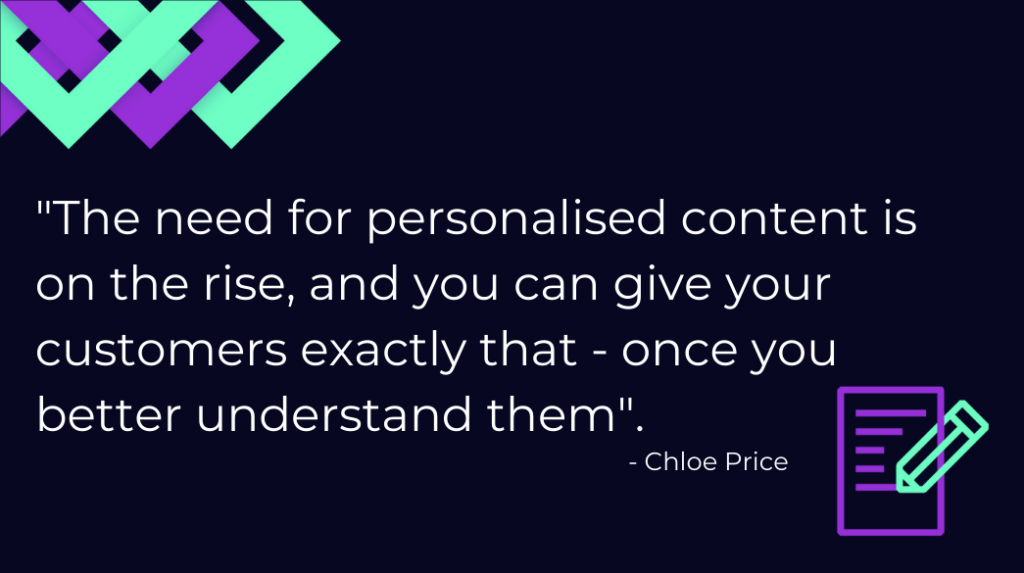
Crafting your digital marketing strategy with Loom
No one really knows exactly what 2022 has in store, but being mindful of current trends is a good way to prepare.
If you feel unsure about your current digital strategy, or are struggling to keep up with the ever-changing industry, then we can help. From PPC & biddable to social media, content and SEO, our expert team will help you thrive throughout 2022 and beyond.
Speak to us today to find out more about our digital marketing services. Call us at 0117 923 2021 or send an email at [email protected] to see how we can help boost your online presence.


